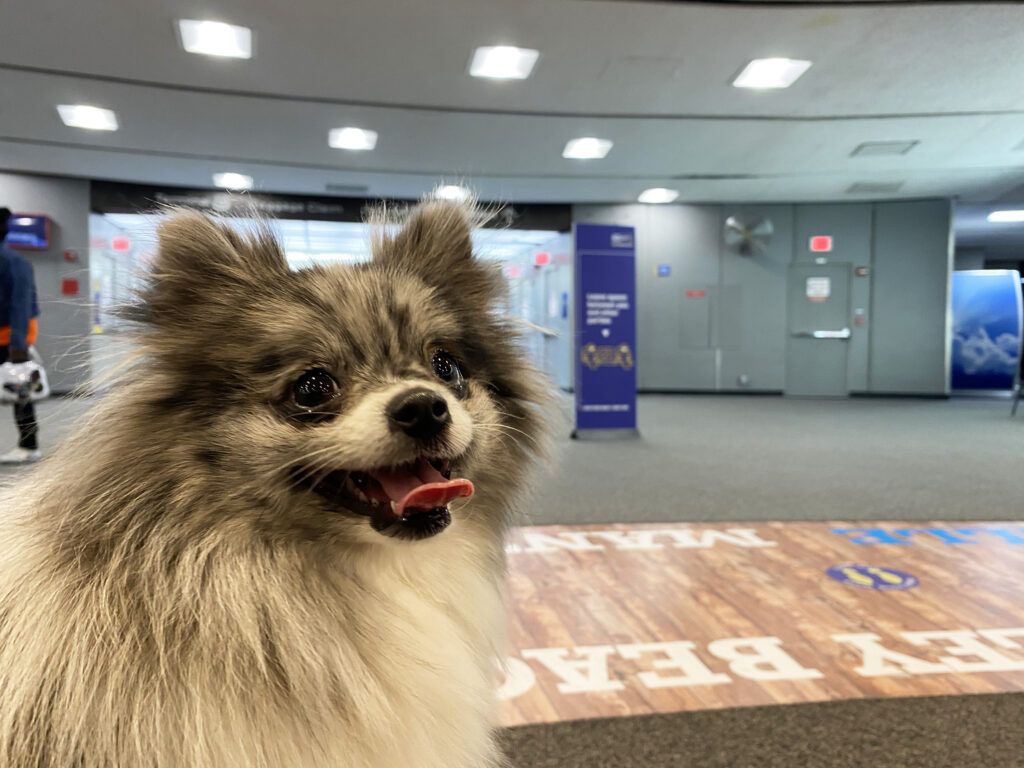One of the perks of having a small dog is that you can fly with them in the cabin as opposed to shipping them cargo, which can not only be expensive but also stressful for the dog. While emotional support animals can no longer fly in the cabin for free, you can pay a pet fee to bring your dog with you on domestic flights, which is around $125 each way (or slightly less on some airlines). Although $250 round trip can sometimes be more than the cost of your own ticket, sometimes it’s worth it to be able to have you furry friend come with you on your travels or when you’re visiting family and friends.
My Pomeranian Luna is only 6.5lbs and I actually chose to get this breed with size in mind. I wanted a dog that I could pop in a carrier and take on the NYC subway, or fly in the cabin if I’m traveling within the U.S. Flying with a dog in cabin is fairly straightforward but it can still be stressful for your dog if they’re new to it and there are some things you’ll need to think about before your trip. Here are my top tips for taking a dog on the plane:
Call to make a reservation
If you’re planning to take your dog in the cabin then you’ll need to make a special reservation for your pet. I’d advise calling them up BEFORE you book your flight as airlines have a limit on the number of pets they can have on the plane. You don’t want to book your flight and then find out they’ve reached the max limit of pets. Check with a representative whether there’s space for your pup in both directions.
The rules for taking dogs on planes vary, but most airlines have a special pet policy page with telephone contact info for their reservations team. I fly with Luna on Delta and the process is pretty straightforward – they just ask for your pets breed and weight information, plus the size of the carrier.
Get an appropriate sized carrier
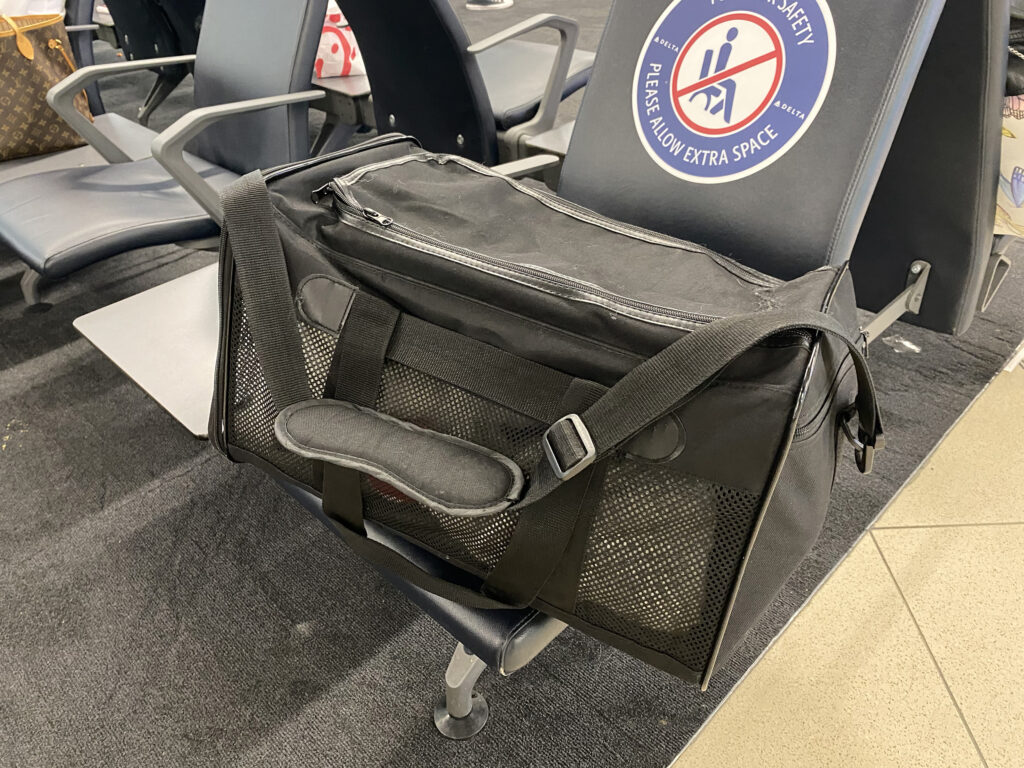
For flying in cabin I’d recommend you go with a soft carrier. They’re more comfortable and homely for your dog, plus they’re lighter and more flexible than hard sided kennels. It’s unlikely that a small dog will manage to destroy it and the soft cases usually have an inner safety clip that you can attach to your dog’s harness in case they try to make a quick escape. Carriers should have plenty of ventilation (3 sides) and be leak-proof.
Each airline has different maximum carrier dimensions so it’s important to check with the airline you’re flying on. You’ll need to be able to fit the carrier under the seat in front of you but different aircraft types have different seat dimensions. A soft sided carrier can easily be squished and collapsed a bit under the seat so the airlines allow slightly larger dimensions for soft carriers than hard carriers.
Most airlines allow soft sided bags around 17″ to 18″ long and 11″ to 14″ wide, but the height can be tricky. Southwest Airlines for instance allows soft carriers up to 8.5” high, while United’s maximum recommended height is 11″.
Your dog needs to be able to comfortable stand up and turn around inside the carrier, which is why most bag manufacturers seem to make their pet carriers around 10.5″- 11″ inches high. This technically wouldn’t fit on airlines like JetBlue or Southwest, but whether the airport staff actually measure your bag is a different story. If your bag is soft you could probably squish it under the seat, but if it really doesn’t fit under the seat in front, there’s a chance you could be kicked off the flight.
Personally I have a bag that is 10.5″ high and I probably would avoid flying with any airlines that have smaller bag dimensions than that because my dog would be too squished. I’ve tried a few bags and the best affordable option is the Sherpa Original Deluxe Airline Approved Pet Carrier, which is good quality and well reviewed on Amazon. Delta is good for flying with a pet, as is United. If you need to find a carrier that’s only 8.5″ high, airlines like JetBlue and Southwest sell their own carriers.
Soft-sided pet carrier sizes by airline:
United Airlines: Recommended maximum 18 inches long x 11 inches wide x 11 inches high. Read the pet policy here.
Spirit Airlines: Maximum container size is 18″x14″x9″ in overall dimensions (L x W x H). Combined weight of pet and carrier must not exceed 40lb. Read the pet policy here.
Delta: Varies by aircraft type but I had no issues making a reservation with a bag that measures 18″ long x 10.75″ wide x 10.75″ high. Call for info. Read the pet policy here.
American Airlines: Doesn’t say on their website. Contact reservations to find out the measurements. Read the pet policy here.
JetBlue: Your pet carrier cannot exceed 17″L x 12.5″W x 8.5″H and the combined weight of your pet and the carrier must not exceed 20 pounds. Read the pet policy here.
Alaska Airlines: 17″ long x 11″ wide x 9.5″ high. Read the pet policy here.
Southwest: Maximum dimensions of 18.5” long x 8.5” high x 13.5” wide. Read the pet policy here.
Frontier: Maximum dimensions for a pet container are 18″ length x 14″ width x 8″ height. Read the pet policy here.
Hawaiian Airlines: Carriers must not exceed the dimensions of 16″ x 10″ x 9.5″ (40 cm x 25 cm x 24 cm). Read the pet policy here.
Line the bottom of the carrier with a blanket
You carrier will likely come with a removable sherpa liner which can be hand washed in case they have an accident. However, I also like to line the bag with a towel or blanket so that if my dog pees in it she doesn’t have to lay in a damp patch. I can either throw the blanket out or stick it in a bag and wash it. Not only does it make things easier to clean up, it also protects a nice new pet carrier from getting ruined.
Get your dog used to its carrier in the week before flying
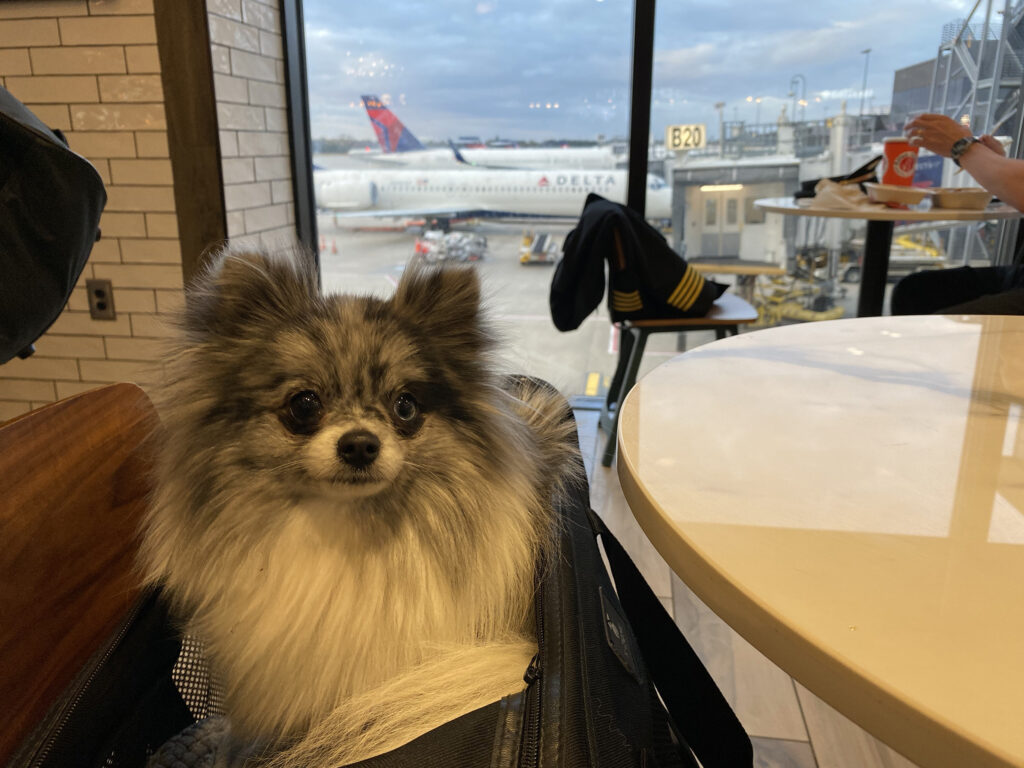
Small dogs are often pretty good with being carried around in bags but if your pet isn’t used to its carrier, it’s a good idea to get them used to it a week or two before the trip. Leave the carrier out on the floor of your home – your pup may decide to take naps in it! Start feeding your dog treats inside the carrier so that they associate it with only positive things. Start walking around with your dog in the bag and perhaps try short trips on the subway. Leave the carrier door open, then work up to having it shut. Ultimately you’ll need to keep the bag closed on the plane, so your dog needs to be comfortable with that.
Pack treats & essentials
Remember to pack things like a collapsible water bowl, harness, leash, small toys and treats for your dog. Having their favorite toys around them will make them feel more at home. Treats will ensure you can keep them happy on the flight and at your final destination.
Don’t forget to bring your dog’s food
You can definitely buy dog food at your destination but remember you might not be able to get straight to a pet store and you might not be able to find the brand you usually use. Being on a trip away from home isn’t the best time to try a new dog food which would upset their stomach. If you’re traveling with a checked suitcase you could pack enough food for your entire trip. If you’re flying carry on or you don’t have space, you can take just enough to tide them over for a couple of days. This gives you time to get down to a pet store and get their favorite food. If you’re staying with friends or family you could arrange to have food delivered from Chewy or Petco so that it’s already there when you arrive.
Luna eats Darwin’s raw pet food, which is frozen and totally impractical for travel because it would thaw out by the time I get to my destination, even with ice packs. When we travel I feed her a dehydrated food instead, although I don’t feed her kibble as it’s not healthy for dogs (she won’t touch it either). Luna is a very fussy eater, but she will eat Sojos freeze dried raw food or Sundays, which comes as air-dried jerky type pieces.
Check if you need a health certificate
Every airline is different but many airlines require a health certificate signed by your veterinarian within 30 days before your date of travel. If that’s the case, remember to factor in the cost of a vet visit as well as your pet fee.
My preferred airline Delta thankfully doesn’t require a health certificate for a dog to travel domestically in the cabin, but you should also check the laws of the state you’re flying to. Some states require just proof of rabies vaccination, while some require a health certificate too. Although technically there’s no-one at arrivals checking these documents, it’s worth having them with you if the state requires it.
As an example, flying New York to Austin round trip:
Texas requires only proof of current rabies vaccination for dogs age 3 months and older but does not require a health certificate.
New York requires a current rabies vaccination for animals 3 months and older, plus a Certificate of Veterinary Inspection issued 30 days or less prior to entry. The certificate is not required if the animal is staying less than 30 days. It’s also not required if the dog is a returning New York resident with current dog license and the dog has been out of state for less than a year.
Take pee pads
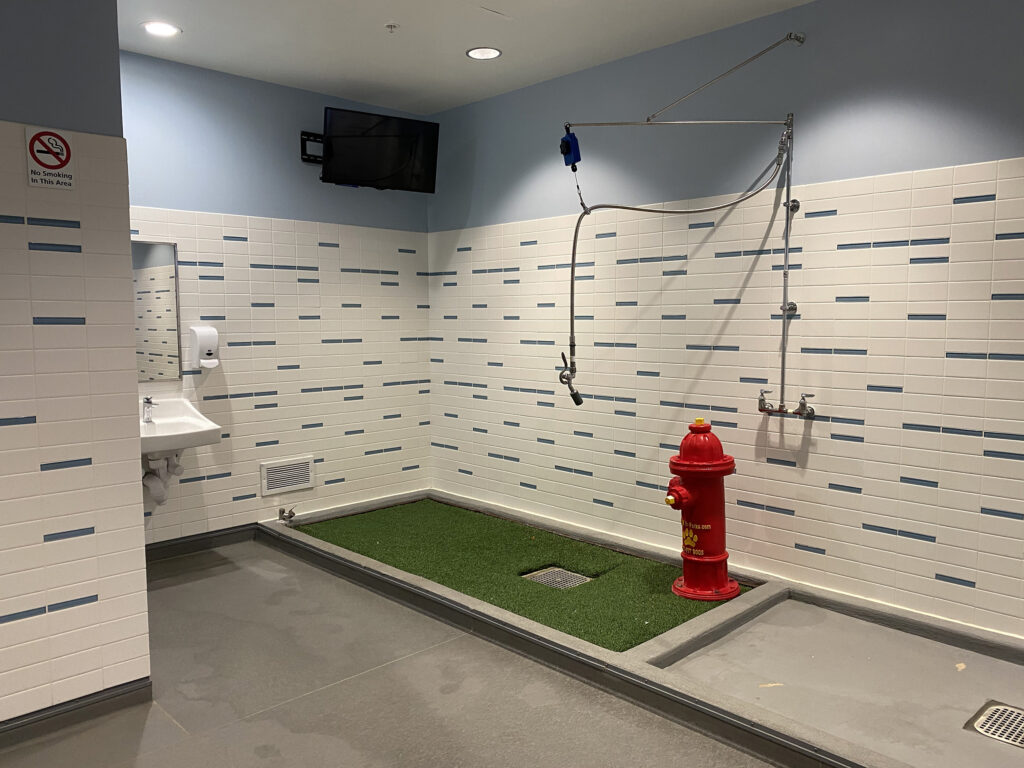
If your dog has been trained to go on pee pee pads then I’d suggest taking a couple of those with you in your dog’s carrier. The airports have pet relief areas but they can be quite smelly and my dog doesn’t like going on the indoor grass patches where all the other dogs have been. I guess Luna just didn’t like the stench and felt it was kind of gross. Having the pee pee pads means you can just put one down on the floor of the bathroom for your pup to go on and then throw it away.
Tire your dog out with a long walk before the flight
If your dog has lots of energy then it will get very restless being shut inside a carry case. The best thing to do is tire your dog out as much as possible before you go to the airport, so take your dog on a long walk and tire them out with games and social interaction. This way your dog is much more likely to just chill and sleep instead of barking or whining during the flight.
Avoid super short layovers
If your journey involves a stopover then you might want to choose a slightly longer layover so that you can take your dog to the bathroom and give them some exercise between flights. If you have only a 30 minute stopover it means you’ll be rushing from gate to gate and may not have time to get them to the pet relief area. Try to choose a stopover of an hour or more so you can take them to the bathroom to go potty.
Be prepared for your dog to stay in its carry case, but walk them if you can
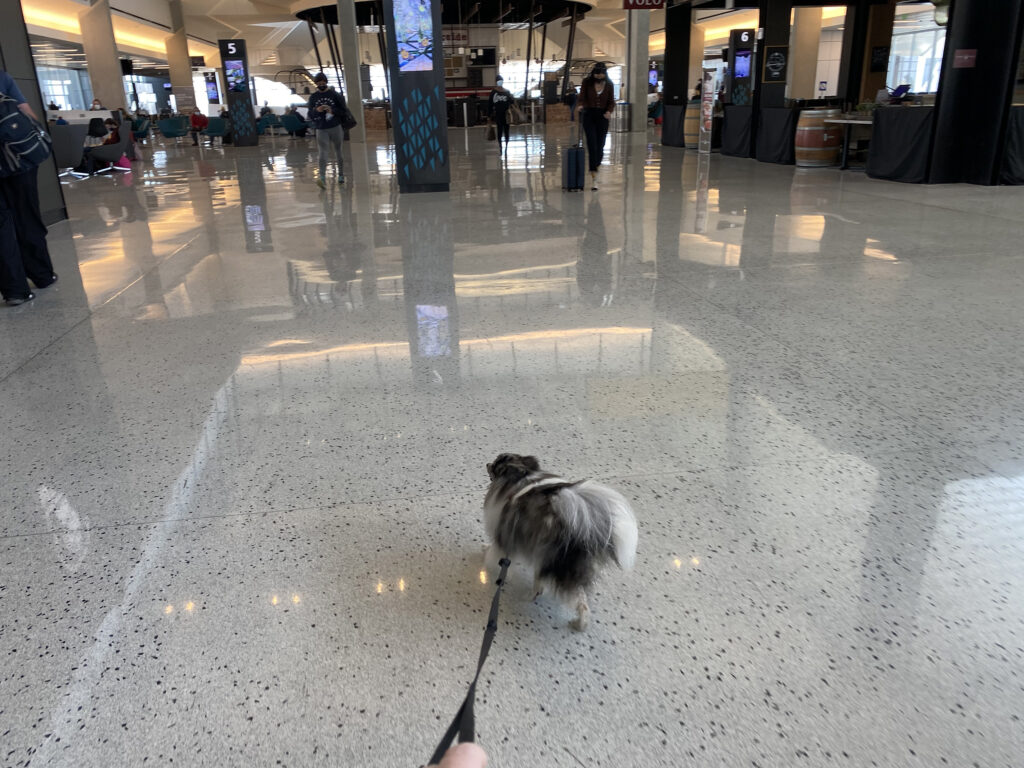
Airports usually require your dog to stay inside its carry case in the airport building, in the airline lounges and at the gate. When you go through security you can take your dog out of its carrier and carry it in your arms through the scanners. The last time I flew out of Newark though the security staff said that I was welcome to put my dog down on the floor and walk her, and I saw many pet owners walking their dogs through the airport. If nobody comes to tell you off, you might want to let your dog out so they can get some exercise before the flight.
Don’t feed them too close to departure
While it’s important to make sure your dog is fed and watered, try to do this around 2 hours before you set off from home. This will give them a chance to digest and pee and poop before you go. Make sure you stick to their regular dog food and don’t feed them any random people foods before you go. Diarrhea in the airport is no fun! I learned this the hard way – my friend had some mango and we gave Luna a piece as it can be a healthy snack for dogs, but she ended up with very loose, watery stools due to the fiber. I had to wash her in the pet relief area at the airport! Eek.
Pay the pet fee
Usually you pay the pet fee at the airport check-in desk and they’ll give you a receipt and a tag to put on the carrier. Pet fees each way are as follows:
- Delta pet fee: $125
- Frontier pet fee: $99
- JetBlue pet fee: $125
- Spirit Airlines pet fee: $110
- American Airlines pet fee: $125
- United pet fee: $125
- Southwest Airlines pet fee: $95
- Hawaiian Airlines pet fee: $60 for inter-island, $225 for other flights
- Alaska Airlines pet fee: $100
Make sure your dog pees before boarding
This goes without saying, but make sure you get your dog to pee before boarding the plane. I usually take Luna to pee outside the terminal before going through security, then once again in the pet relief area after security. You’ll find pet relief areas throughout the airport – just look at the airport map online or in the terminal to find your closest one.
Carry water with you but monitor their intake
It’s important to make sure your dog stays hydrated, so carry a portable water bottle (I have this MalsiPree one from Amazon) or collapsible water bowl that you can fill up at the airport water stations. Remember you can’t take a bottle of water more than 100ml through security. Monitor their intake and make sure they go potty because you don’t want them bursting for the toilet on the plane.
Give them a calming treat when on the plane
When you get on the plane you’ll be required to keep your dogs carry case closed and under the seat in front of you. At this point it’s best to try to give them some sort of calming treat that they can go to town on while inside the kennel. Try a stuffed kong or frozen treat. Make sure they’re as comfortable as possible. However, some dogs won’t eat when they’re stressed or away from home so don’t be completely surprised if your dog doesn’t eat the treat.
Book a window seat
On my first trip with Luna I was given an aisle seat and I soon realized this was kind of annoying. People are constantly walking up and down the aisle, which is noisy. Sitting in the window seat gives you some privacy and the cabin crew are less likely to notice if your dog’s head is sticking out of the bag.
If your dog is whining, put your dog’s carry case on your lap while in flight
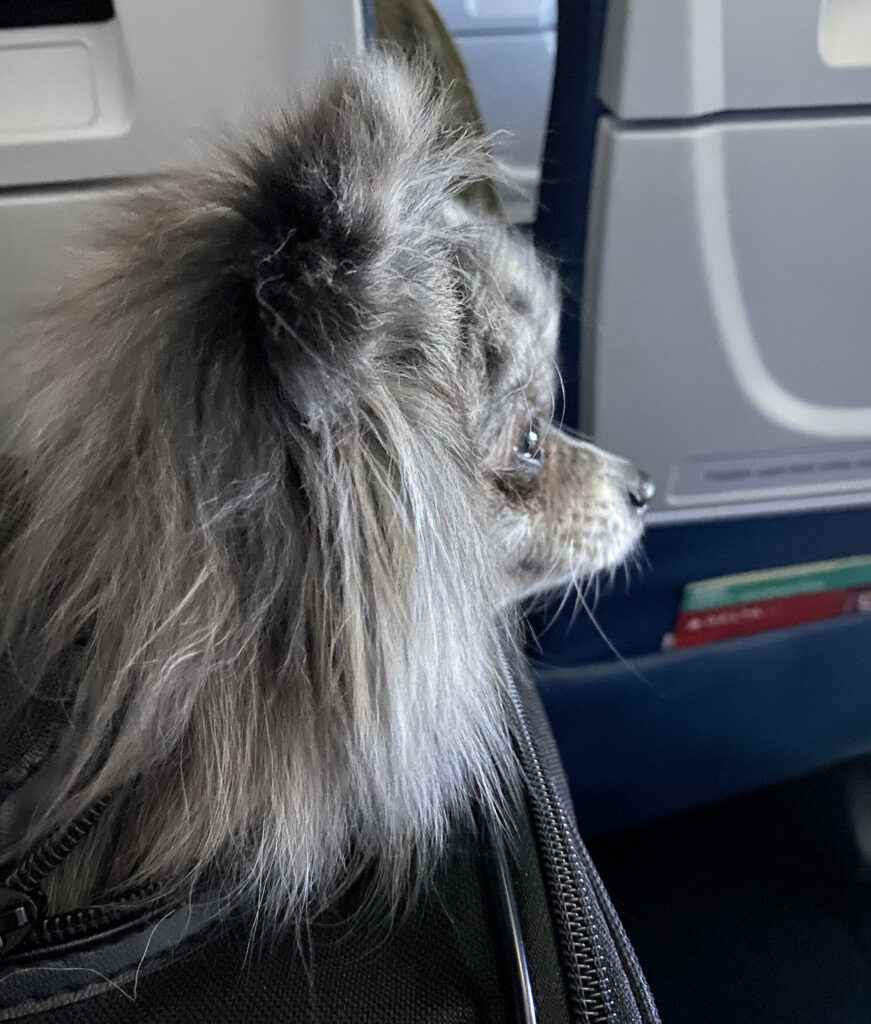
My dog loves her carry case and sleeps in it all the time but she hates being on the floor where it’s dark and she can’t see what’s going on. She LOVES to greet strangers and she likes to be around me so of course why would she like to be down on the ground under the seat? The sound of wheeled suitcases and footsteps on the cabin floor can be disturbing too.
This can all lead to whining and little barks to get out of the carrier. It’s embarrassing and as a dog owner you just want the ground to swallow you up. So how can you stop a dog barking on the plane?
If exercise and treats didn’t work, the good news is that as soon as you’re up in the air the cabin crew will usually let you put your dog’s carry case on your lap. You’re supposed to keep the door of the case closed at all times, but you can put a hand in to comfort your dog and pet them. Sometimes the cabin crew are sympathetic and don’t mind the dog’s head poking out, but if they insist the bag remains closed, do as they say.
If your dog is quiet, leave them alone
On the flip side, if your dog is tired and chilling in its case then its best to just let the dog relax and sleep in the carrier on the floor. If Luna is very tired I just leave the case on the floor until she calms down and goes to sleep. If you start moving around and putting your hand in the case this can set them off. Dogs are very good at figuring out how to get attention so if you give them a little bit of attention, it can open the floodgates.
Use sedatives as a last resort
If your dog is an anxious flyer you can consult your vet to prescribe a mild sedative for the journey, however, these should really only be used as a last resort. Try the above methods first and keep the sedative as a backup if you can.
It’s up to you to assess whether you think your dog has the type of personality to travel. If you feel they’ll be too stressed out, leave them at home with family or friends or hire a sitter on Rover. With all the people, sounds and changes in cabin pressure, it can be stressful for pups who have no idea what’s going on. If you do plan to fly with your small dog in the cabin, make sure you plan ahead, make a checklist and tire them out as much as possible before the journey.

